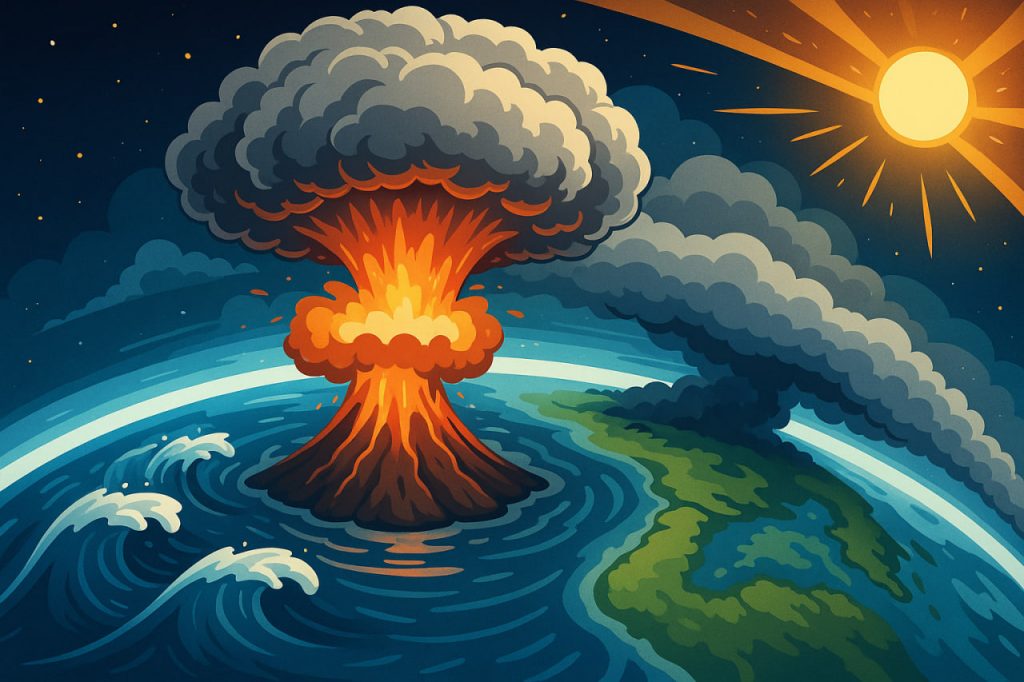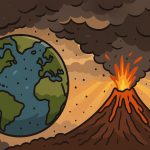The 2022 eruption of Hunga Tonga–Hunga Haʻapai was one of the most powerful volcanic explosions ever recorded, sending shockwaves around the world and reaching the edge of space. It released energy equivalent to hundreds of Hiroshima-sized nuclear bombs, generated massive tsunamis, and injected enormous volumes of water vapor and ash into the atmosphere. But what if this cataclysm had been 1,000 times stronger? Such an event would not just affect nearby islands — it would have transformed the entire planet.
Magnitude of Energy and Immediate Effects
If the eruption were 1,000 times more energetic, its explosive force would be nearly incomprehensible. The original blast released an estimated 50 megatons of TNT energy; magnified by 1,000, this would exceed 50 gigatons, roughly comparable to a large asteroid impact. The shockwave would circle the planet multiple times, destroying coastal infrastructure across the Pacific and even inland regions. Entire islands in the Tonga archipelago would vanish, replaced by a crater hundreds of kilometers wide. The air blast alone would level forests and settlements within thousands of kilometers.
Tsunamis and Oceanic Disruption
Such an eruption would cause planet-wide tsunamis. Waves exceeding 100 meters in height could devastate coasts across the Pacific Rim — from Japan and Australia to the Americas. Underwater cables, ports, and marine ecosystems would be obliterated. The ocean’s temperature and salinity balance would change locally due to massive amounts of heated water and gas emissions. Global shipping, communication, and trade would suffer catastrophic interruptions lasting years.
Atmospheric and Climatic Impact
A thousandfold increase in energy would inject colossal volumes of ash, sulfur dioxide, and water vapor into the stratosphere, forming a thick global haze. Sunlight would be drastically reduced, triggering a volcanic winter. Average global temperatures could fall by 5–10°C, disrupting agriculture worldwide. Photosynthesis would slow, ecosystems would collapse, and food production would decline sharply. Acid rain and altered rainfall patterns would further damage vegetation. The ozone layer might suffer from chemical reactions involving volcanic gases, increasing UV radiation exposure after the atmosphere clears.
Long-Term Ecological and Human Consequences
A super-eruption of this scale could cause mass extinctions similar to those in Earth’s past. Crops would fail, animal populations would decline, and food shortages could spark famine and conflict. The sudden drop in global temperatures could last for decades, shifting climate zones and disrupting ocean currents. Humanity’s infrastructure — from power grids to transportation — would struggle to recover amid ashfall and persistent cooling. Economically, the impact could exceed trillions of dollars, and population displacement might reach hundreds of millions.
Global Communication and Space Effects
The real 2022 eruption disturbed the ionosphere and even damaged satellites. A 1,000× stronger blast would wreak havoc on modern technology. Electromagnetic disturbances could disable GPS and satellite networks, cutting off communication and navigation systems worldwide. Radio blackouts and magnetic disruptions could resemble — or exceed — those caused by a major solar storm. In the upper atmosphere, charged particles from the eruption could even interact with Earth’s magnetic field, creating temporary aurora-like phenomena visible across the planet.
Can Science Predict or Prevent Such Events?
While no technology can prevent a supervolcanic eruption, science can monitor, model, and mitigate its impacts. Satellite networks, oceanic sensors, and seismic stations can detect early warning signs. International cooperation and emergency plans could reduce human losses through evacuation and disaster preparation. Moreover, studying past volcanic winters helps scientists understand how to adapt agriculture and infrastructure to sudden cooling events.
Comparing With Other Global Catastrophes
A thousandfold Tonga eruption would rival the Toba super-eruption 74,000 years ago, which nearly wiped out early human populations. It would also approach the climatic effects of a small asteroid impact, injecting similar amounts of dust and aerosols into the atmosphere. However, unlike an asteroid strike, this event would come from Earth’s interior — a reminder of the planet’s own destructive potential.
Interesting Facts
- The 2022 Tonga eruption sent an ash plume 57 km high, the tallest ever recorded.
- If magnified 1,000×, the plume could potentially reach the edge of space (over 100 km).
- Shockwaves from the real eruption traveled around the world four times; a 1,000× blast might generate a shock comparable to a meteor impact.
- The sound of the 2022 event was heard as far as Alaska, 9,000 km away.
- The 1,000× scenario could darken the sky globally, reducing sunlight for years — a true volcanic winter.
Glossary
- Super-eruption — a volcanic explosion with an ejecta volume exceeding 1,000 cubic kilometers.
- Volcanic winter — a period of global cooling caused by volcanic aerosols blocking sunlight.
- Stratosphere — the second layer of Earth’s atmosphere, where long-lived aerosols accumulate.
- Ionosphere — an upper atmospheric layer affected by charged particles, essential for radio communication.
- Toba eruption — a prehistoric super-eruption in Indonesia about 74,000 years ago that caused massive global cooling.


